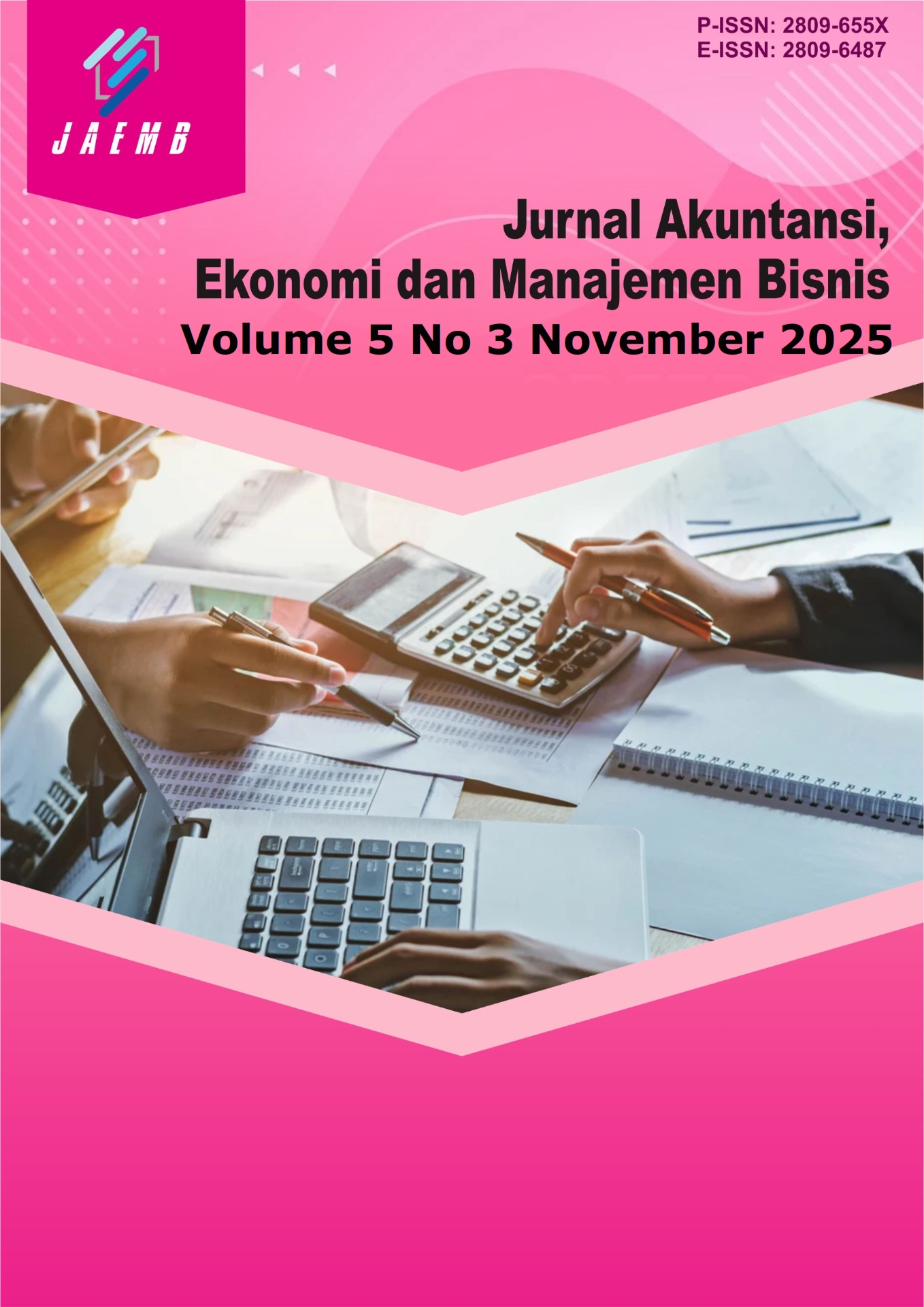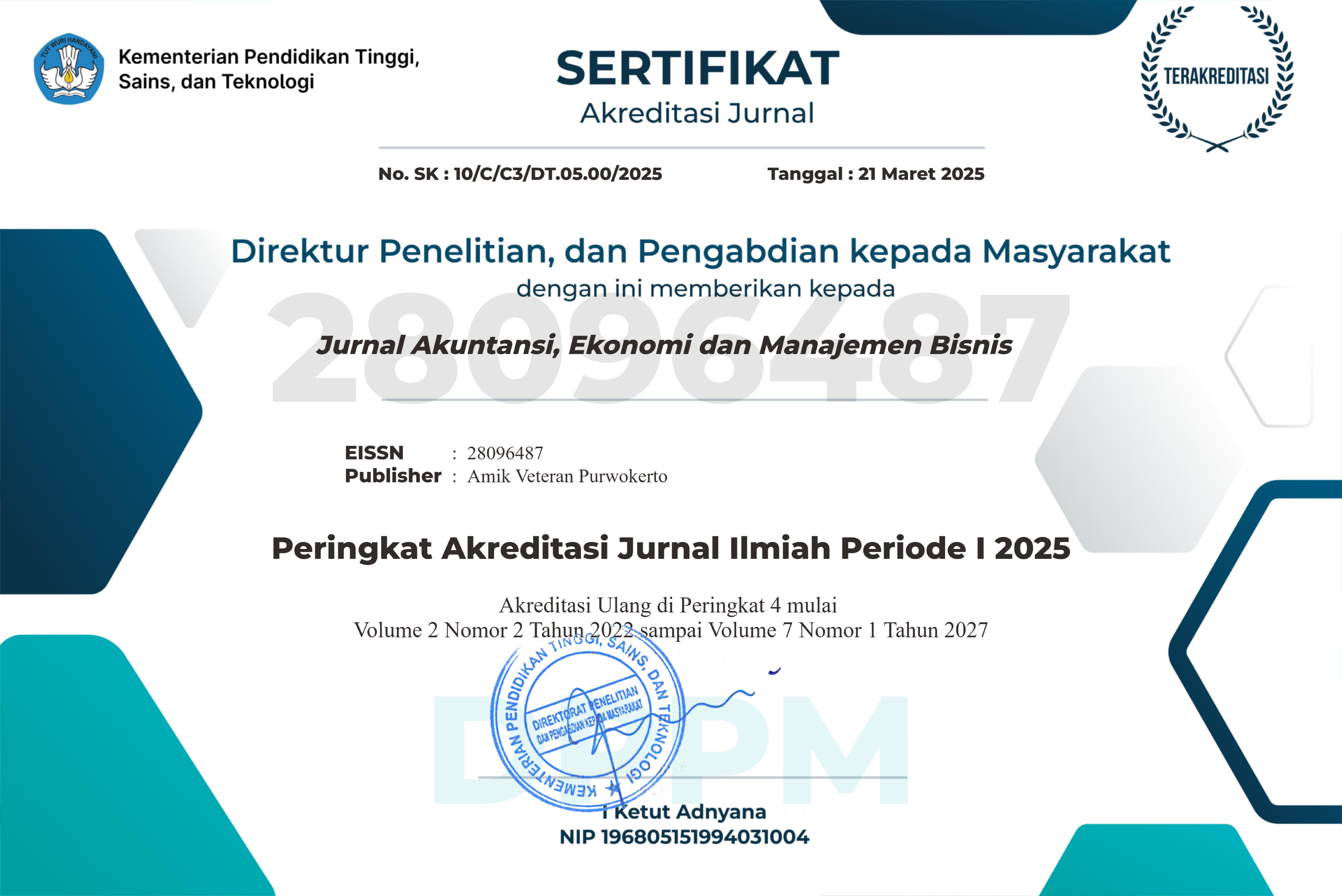Pengaruh Keterhubungan Sosial Dan Citra Destinasi Wisata Tersembunyi Terhadap Niat Kunjung Wisata Melalui Rasa Takut Tertinggal Pada Mahasiswa
DOI:
https://doi.org/10.55606/jaemb.v5i3.7564Keywords:
social connection, destination image, fear of missing outAbstract
A person's intention to take action or make decisions will be influenced by many factors, both from within themselves and external factors. The intention to visit among students will be influenced by social connectivity and the image of hidden tourist destinations. The purpose of this research is to analyze the effect of social connectivity and the image of hidden tourist destinations on the intention to visit tourism through the fear of missing out. The sample of this study consists of students from the Faculty of Economics and Business at Stikubank University. Data collection techniques used a questionnaire distributed via Google Forms. Data analysis techniques used SEM-PLS. The research results show that partially, social connection and destination image have a significant effect on the intention to visit. The fear of missing out mediates the effect of social connection on the intention to visit. However, the fear of missing out does not mediate the effect of the hidden destination image on the intention to visit.
References
[1] M. Y. Yusuf, I. Innayatillah, I. Isnaliana, and H. Maulana, “The Determinants of Tourists’ Intention to Visit Halal Tourism Destinations in Aceh Province,” Samarah J. Huk. Kel. dan Huk. Islam, vol. 5, no. 2, p. 892, Dec. 2021, doi: 10.22373/sjhk.v5i2.9270.
[2] Y. D. Lestari, F. Saidah, and A. N. Aliya Putri, “Effect of destination competitiveness attributes on tourists’ intention to visit halal tourism destination in Indonesia,” J. Islam. Mark., vol. 14, no. 4, pp. 937–965, Mar. 2023, doi: 10.1108/JIMA-12-2020-0368.
[3] N. Anannukul and C. Yoopetch, “The determinants of intention to visit wellness tourism destination of young tourists,” Kasetsart J. Soc. Sci., vol. 43, no. 2, pp. 417–424, 2022, doi: 10.34044/j.kjss.2022.43.2.20.
[4] J. A. Roberts and M. E. David, “The Social Media Party: Fear of Missing Out (FoMO), Social Media Intensity, Connection, and Well-Being,” Int. J. Human–Computer Interact., vol. 36, no. 4, pp. 386–392, Feb. 2020, doi: 10.1080/10447318.2019.1646517.
[5] N. S. Patani and K. N. Babu, “Smartphone Use, Fear of Missing Out (FOMO) and Social Connectedness among College Students,” InternatioanJournalofIndianPsychology, vol. 11, no. 3, 2023, doi: 10.25215/1103.427.
[6] A. Hoffman, A. Mehrpour, and C. Staerklé, “The Many Faces of Social Connectedness and Their Impact on Well-being,” in Withstanding Vulnerability throughout Adult Life, Singapore: Springer Nature Singapore, 2023, pp. 169–187. doi: 10.1007/978-981-19-4567-0_11.
[7] A. Nankani and D. Vijayan, “Social connectedness and dimensions of emerging adulthood among young adults in India,” World J. Adv. Res. Rev., vol. 22, no. 1, pp. 422–431, Apr. 2024, doi: 10.30574/wjarr.2024.22.1.1091.
[8] A. Andrada and A. Doromal, “Social Connectedness among Emerging Adults in a State University in Western Visayas,” Tech. Soc. Sci. J., vol. 58, pp. 142–158, Jun. 2024, doi: 10.47577/tssj.v58i1.11135.
[9] B. Mulyono, “Pengaruh FoMO terhadap social connectedness yang Dimediasi oleh Penggunaan Media Sosial,” Bul. Ris. Psikol. dan Kesehat. Ment., vol. 1, no. 2, pp. 1190–1198, 2021.
[10] H. Zhou, T. Sun, K. Zhu, J. Li, and N. Ito, “‘Are ad endorsements really annoying?’ The impact of advertising in short-form tourism videos on tourists’ information processing,” Curr. Issues Tour., pp. 1–20, Jul. 2024, doi: 10.1080/13683500.2024.2371029.
[11] E. Ulucan, “THE IMPACT OF SOCIAL MEDIA ADDICTION AND FOMO ON TOURISTIC PURCHASING DECISIONS: CONQUERING FOMOURISM AND FOMOURISTS AS A NEW CULTURE,” J. Acad. Soc. Sci., vol. 149, no. 149, pp. 229–248, 2024, doi: 10.29228/ASOS.74577.
[12] S. An, Y. Choi, and C.-K. Lee, “Virtual travel experience and destination marketing: Effects of sense and information quality on flow and visit intention,” J. Destin. Mark. Manag., vol. 19, p. 100492, Mar. 2021, doi: 10.1016/j.jdmm.2020.100492.
[13] L. J. Harrison and J. A. Mead, “Exploring the fear of missing out (FOMO) and customer bonds in service relationships,” J. Serv. Mark., vol. 38, no. 5, pp. 636–655, Jun. 2024, doi: 10.1108/JSM-07-2023-0261.
[14] B. McKercher, B. Prideaux, and M. Thompson, “The relationship between accommodation type and tourists’ in-destination behaviour,” Tour. Recreat. Res., vol. 50, no. 1, pp. 14–23, Jan. 2025, doi: 10.1080/02508281.2023.2221070.
[15] W.-K. Tan and Y.-C. Chen, “Tourists’ work-related smartphone use at the tourist destination: making an otherwise impossible trip possible,” Curr. Issues Tour., vol. 24, no. 11, pp. 1526–1541, Jun. 2021, doi: 10.1080/13683500.2020.1814706.
[16] U. Zaman, “Nexus of Regenerative Tourism Destination Competitiveness, Climate Advocacy and Visit Intention: Mediating Role of Travel FOMO and Destination Loyalty,” Sustainability, vol. 16, no. 17, p. 7827, Sep. 2024, doi: 10.3390/su16177827.
[17] Sasmita, Sarah, and AbdillahYusri, “Pengaruh Social Media Marketing Dan Influencer Terhadap Decision To Visit Melalui Fear Of Missing Out Dan Trust (Survei Pada Pengunjung Jawa Timur Park 3 Pengguna Aplikasi Tiktok),” Magister thesis, Universitas Brawijaya., 2024.
[18] J. Brailovskaia and J. Margraf, “From fear of missing out (FoMO) to addictive social media use: The role of social media flow and mindfulness,” Comput. Human Behav., vol. 150, p. 107984, Jan. 2024, doi: 10.1016/j.chb.2023.107984.
[19] S. S. Chan et al., “Social media and mindfulness: From the fear of missing out (FOMO) to the joy of missing out (JOMO),” J. Consum. Aff., vol. 56, no. 3, pp. 1312–1331, Sep. 2022, doi: 10.1111/joca.12476.
[20] M. Mohanan and S. K. Shekhar, “A Study On The Mediating Effect Of Fomo On Social Media (Instagram) Induced Travel Addiction And Risk Taking Travel Behavioral Intention In Youth,” J. Content, Community Commun., vol. 14, no. 7, pp. 57–67, 2021, doi: 10.31620/JCCC.12.21/06.
[21] C. Aji and R. K. Andadari, “Media Sosial Instagram Dan Website Terhadap Minat Kunjung Wisatawan,” J. Penelit. dan Pengemb. Sains dan Hum., vol. 5, no. 1, pp. 54–63, Jun. 2021, doi: 10.23887/jppsh.v5i1.33774.
[22] L. Kodriyah and H. B. Putra, “htt Experience on Revisit Intention Influence of Memorable Culinary Mediated by Place Identity in Semarang,” vol. 9, no. September, pp. 294–301, 2024.
[23] S. Nugraha and H. B. Putra, “The influence of memorable tourism experiences , place attachments and place identity in enjoying local culinary food on the revisit intention the old city of Semarang,” J. Ekon., vol. 13, no. 01, pp. 1548–1558, 2024, doi: 10.54209/ekonomi.v13i01.
[24] T. Sihotang and H. Putra, “The Influence of E-Word of Mouth, Word of Mouth, And Destination Brand Love on Revisit Intention In The Tourism Context of Visiting Lake Toba,” 2023, doi: 10.4108/eai.12-7-2023.2340945.
[25] M. L. Cheung, H. Ting, J.-H. Cheah, and M.-N. S. Sharipudin, “Examining the role of social media-based destination brand community in evoking tourists’ emotions and intention to co-create and visit,” J. Prod. Brand Manag., vol. 30, no. 1, pp. 28–43, Jan. 2021, doi: 10.1108/JPBM-09-2019-2554.
[26] P. Tavitiyaman, H. Qu, W. L. Tsang, and C. R. Lam, “The influence of smart tourism applications on perceived destination image and behavioral intention: The moderating role of information search behavior,” J. Hosp. Tour. Manag., vol. 46, pp. 476–487, Mar. 2021, doi: 10.1016/j.jhtm.2021.02.003.
[27] D. W. Mandagi, T. Soewignyo, D. F. Kelejan, and D. C. Walone, “From a hidden gem to a tourist spot: Examining brand gestalt, tourist attitude, satisfaction and loyalty in Bitung city,” Int. J. Tour. Cities, Aug. 2024, doi: 10.1108/IJTC-10-2023-0217.
[28] N. A. Putri and H. B. Putra, “The effect of social-media-influencer-popularity on purchase-intention of a fashion-product through emotional attachment,” Mantik J., vol. 7, no. 4, pp. 2685–4236, 2024.
[29] G. Haryono and A. Albetris, “Peranan Komunikasi Pemasaran Pariwisata Melalui Pemanfaatan ETourism Marketing untuk Meningkatkan Niat Berkunjung Wisatawan,” Ekon. J. Econ. Bus., vol. 6, no. 1, pp. 136–143, 2022.
[30] S. S. Alam, “Malaysian Chinese Generation Z and Intention to Visit China: Moderating Role of Destination Familiarity,” J. China Tour. Res., pp. 1–32, Mar. 2025, doi: 10.1080/19388160.2025.2480596.
[31] Sugiyono, Metode Penelitian Kuantitatf, Kualitatif, dan R&D, 2nd ed. Bandung: Alfabeta, 2019.
[32] S. Arikunto, Prosedur Penelitian: Suatu Pendekatan Praktik. Jakarta: Rineka Cipta, 2018.
[33] N. S. Sukmadinata, Metode Penelitian Pendidikan. Bandung: PT Remaja Rosdakarya, 2016.
[34] I. Ghozali, Structural equation modeling : metode altenatif dengan partial least square (PLS). Semarang: Undip Pres, 2020.
Downloads
Published
How to Cite
Issue
Section
License
Copyright (c) 2025 Jurnal Akuntansi, Ekonomi dan Manajemen Bisnis

This work is licensed under a Creative Commons Attribution-ShareAlike 4.0 International License.








